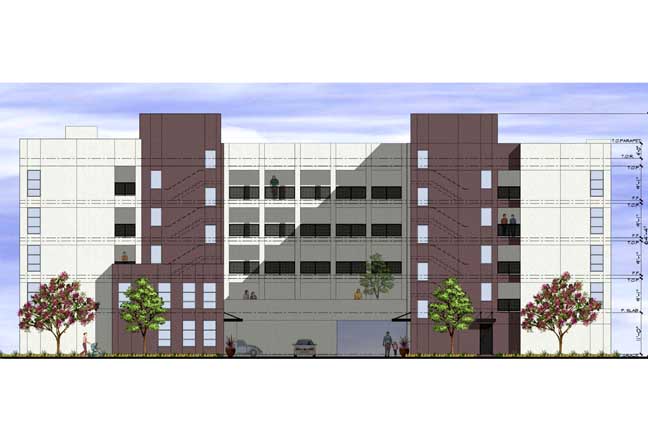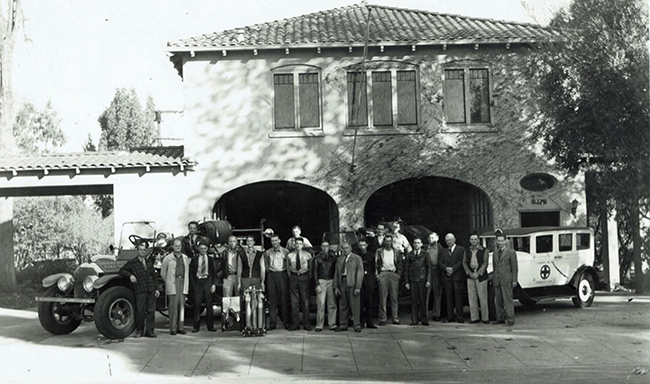La Verne, San Dimas pushback on supportive housing

This elevation shows the street level view of the proposed permanent supportive housing project near San Dimas and La Verne. Illustration/courtesy of National CORE
by Steven Felschundneff | steven@claremont-courier.com
Residents of La Verne and San Dimas received a recent surprise that might sound familiar to people who live near the proposed Larkin Place development in Claremont.
About two weeks ago they began hearing that a company called National CORE was deep in the process of securing funding for a 54-unit affordable housing development adjacent to their neighborhoods.
The company wants to build a five-story permanent supportive housing project on a .64 acre lot at 740 E. Foothill Blvd. which is in unincorporated Los Angeles County between the two cities. Plans call for 53 one-bedroom apartments and a two-bedroom manager’s unit, with a community center and 19 parking spaces for cars, six short-term bicycle spots and 48 long-term bike spaces.
For those unfamiliar with the location, it’s on the south side of the street about 300 yards west of the intersection of Baseline Road and Foothill Boulevard in La Verne. For years it was the site of a popular drive-in dairy, now Olive’s Neighborhood Market, a bespoke grocery store.
Similar to Larkin Place in Claremont, the future residents of 740 Foothill would be people who earn at or below 30% of the area median income. According to a fact sheet from Fifth District Supervisor Kathryn Barger, the residents will all be “seniors who are working or retired and are experiencing homelessness.”
Because it is permanent supportive housing, the tenants will live independently, with no requirement to attend therapy sessions or submit to drug tests. However, there will be voluntary supportive services on site and the manager will be accessible 24 hours a day seven days a week.
Like Jamboree’s project here in Claremont, there is very little anyone locally can do to prevent the “740 Foothill” project from being built. That’s because of a slate of relatively new laws from Sacramento designed to streamline the construction of affordable housing across the state.
Under Assembly Bill 2162, permanent supportive housing projects are exempt from discretionary approvals by local city councils or planning commissions. The development is considered “by-right,” meaning the approval process is ministerial, with only objective standards such as building codes coming into play. It is also exempt from environmental impact reports and qualifies for increased building height and extra units under Californian’s density bonus law.
“The County of Los Angeles and the cities of San Dimas and La Verne have no authority to stop this affordable housing project from being built,” according to an open letter from Supervisor Barger. As mentioned in my fact sheet, recent changes to state law have stripped local government of its power to deny affordable housing or supportive housing projects to house the homeless. The State Legislature and the Governor’s Office enacted this legislation to address the statewide shortage of housing but have effectively.”
Elected officials in San Dimas and La Verne say they were not notified about the project even though it had been in the works for months, and only learned about it on April 18, the morning the Los Angeles County Board of Supervisors was set to vote on $7 million in county funding for its construction.
“The project has been under review by the LA County Department of Regional Planning for several months and the developer applied to the LA County Development Authority Multifamily Rental Housing Notice of Funding Availability in November 2022,” according to a joint news release from San Dimas and La Verne officials.
According to Helen Chavez, Barger’s assistant chief deputy and communications director, elected officials in the two cities were informed abut the upcoming vote on April 11, seven days before the board of supervisors’ meeting.
Supervisor Barger, who represents the area, apologized for the oversight in informing local communities about the projected vote and made a motion during the April 18 meeting that the vote to fund National CORE’s supportive housing be tabled to provide an opportunity for community engagement.
“While we understand that this a state regulated project in which the state has intentionally limited city and county local control over what the development will be, the delay allows both cities to work with the County and the developer to ensure the proper community outreach with objective information about the project,” according to the joint news release.
Residents adjacent to the proposed project were caught off guard by the news and expressed concerns about potential safety issues they fear will come with so many formerly unhoused people in one location. They are apprehensive about the proximity of schools, including a Montessori academy in the shopping plaza next door. They also worry about increased traffic, rising crime and say such a large building would be out of character with their neighborhood.
Local opposition organized a Facebook group called “Stop the San Dimas La Verne Hidden Project” and held a rally in San Dimas Canyon Park on Sunday that was attended by about 400 people. One member, Rich Gill, set up a Change.org petition calling on all five county supervisors to oppose the development. It had 3,198 signatures as of Wednesday morning.
Given the project’s by-right status, those who oppose it are hoping to convince the Board of Supervisors to at least reject the $7 million in discretionary funding in its control. In addition, Barger had indicated she was speaking with officials at the Los Angeles County’s Department of Regional Planning about the project and “to address concerns raised by my office that are within the department’s ability to require of the developer.”
According to Chavez, the supervisor shared her concerns about the project’s incompatibility with the neighborhood, including its size, scale, and character.
“While the Department of Regional Planning cannot require the developer to modify the density, height of the project, or minimum setbacks from adjacent properties, they can ask the developer to address specific issues such as façade design as well as site layout, which includes the location of driveways and on-site parking,” Chavez said.
A vote on the county funding was set for the May 16 Board of Supervisors meeting but has now been delayed for at least 30 days.










0 Comments